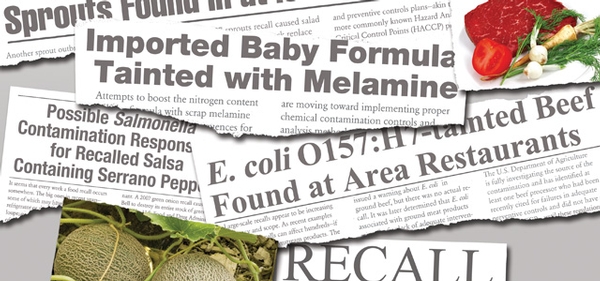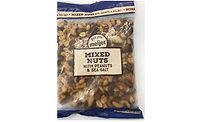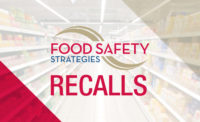It seems that every week a food recall occurs somewhere. The big ones in recent years—some of which may have affected your own refrigerator or pantry—have involved cantaloupe, peanuts, ground beef, eggs and all kinds of vegetables, whether bagged or not. At the same time, the regulatory, legal and communications issues involved in recalls are evolving rapidly. More than ever, food manufacturers need to understand the challenges involved in a recall and have both personnel and infrastructure in place to respond.
A Changing Landscape
Large-scale recalls appear to be increasing in frequency and scope. As recent examples illustrate, these recalls can affect hundreds—if not thousands—of downstream products. The outcome can be crippling, even for manufacturers that were not responsible for the contamination at issue.
In 2009, the Salmonella contamination associated with Peanut Corporation of America products led to one of the largest recalls in U.S. history. It affected 1,790 separate downstream products, leading to nine deaths and 691 reports of food poisoning. The company, which had manufactured roughly 2.5 percent of the nation’s peanuts, later filed for bankruptcy and liquidation.
Before that, there were several ground beef recalls, including the Hallmark Westland Beef recall in 2008 that involved 143 million pounds of beef. More recently, Wright County Egg of Galt, IA, initiated a massive shell egg recall, which again affected many downstream manufacturers as well as retailers. All told, more than 500 million eggs were involved in a nationwide recall.
In recent years, vegetables have also been recalled. These recalls can prove particularly challenging, because in many instances it is hard to identify the source of the contaminant. A 2007 green onion recall caused Taco Bell to destroy its entire stock of green onions while the U.S. Food and Drug Administration (FDA) was trying to figure out where the contamination originated. Ultimately, however, it was determined that the outbreak was caused by packaged lettuce. Several years ago, a bagged spinach recall occurred. Again, a number of companies suffered the problems associated with the recalls before the source was identified. Many products were pulled from shelves and consumers avoided bagged spinach long after the threat of actual contamination had passed. Similarly, in 2008, FDA issued a warning about Salmonella in tomatoes, but there was no actual recall. It was later determined that Salmonella associated with these vegetables did not come from the tomatoes at all; it came from peppers. But the tomato industry suffered losses nonetheless. The lesson: The impact of a recall can be enormous, even if your product was not contaminated.
Companies must therefore be prepared with systems in place to help avoid recalls and minimize the damage when they do occur.
Understanding and Preparing for Regulatory Challenges
One of the most important aspects of of preparing for a recall is understanding the regulatory issues involved. For most food manufacturers outside the meat and poultry sectors, this will involve dealing with FDA.
Key Regulatory Issues
The food safety regulatory landscape underwent a a major overhaul in January of 2011 when President Barack Obama signed the Food Safety Modernization Act (FSMA) into law. The FSMA makes a number of important changes to existing law. Most significantly, when fully implemented, it will require most food manufacturers to utilize hazard analysis and preventive controls plans—akin to the more commonly known Hazard Analysis and Critical Control Points (HACCP) plan—and to verify the compliance systems of their foreign suppliers. The FSMA also vests FDA with mandatory recall authority and requires FDA to engage in risk-based inspections (mandating that high-risk facilities be inspected every 3 years). FDA plans to fold the requirement for a hazard analysis and preventive controls plan into existing Good Manufacturing Practices (GMPs) regulations, along with preventive controls requirements relating to intentional adulteration, produce safety and sanitary transportation. Congress drafted these requirements to take effect for most manufacturers in July 2012. FDA failed to issue regulations needed to implement the section, however, and the agency has stated that it will not enforce the HACCP and preventive controls plan requirements until these regulations are issued in final form and made effective—which might be years from now. Similarly, FDA will not enforce the requirements of FSMA’s foreign supplier verification section, which will require supplier verification activities for imported foods, until final rules are issued. Nevertheless, many sectors of the food industry are moving toward implementing hazard analyses and preventive controls plans and foreign supplier strategies.
One aspect of the FSMA likely to drive more recalls is FDA’s inspection mandate. Owners of registered food facilities have probably noticed a marked increase in the frequency and vigor of inspections. Even though FDA has delayed the implementation of FSMA’s hazard analysis and preventive controls provision, inspectors are increasingly asking questions relating to HACCP concepts. The HACCP approach requires a manufacturer to qualify suppliers and have validated processes in place to control identified hazards. These activities must be monitored and verified, including through the use of testing where appropriate. Importantly, everything must be documented for FDA to accept that it has indeed occurred. Manufacturers have reported instances of inspectors asking questions about these issues during inspections under the currently applicable GMP regulations. There have been a number of recalls following such inspections, as well as an apparent increase in warning letters regarding GMP violations over the last 6–12 months.
Another key aspect of the FSMA is FDA’s new mandatory recall authority. Recalls under previous law were considered “voluntary,” but manufacturers that did not recall contaminated food risked criminal charges for adulteration, civil liability to consumers and adverse publicity. Due to these external pressures, companies rarely refused FDA’s request to issue a recall. Thus, the new mandatory recall authority is not likely to drive many new recalls, although it might lead to disputes over timing and scope of such recalls.
Although the FSMA is front and center for many in the industry, manufacturers should not forget FDA’s pre-FSMA food safety requirements, such as the Reportable Food Registry, which requires manufacturers to report food that poses a reasonable probability of “serious adverse health consequences or death to humans or animals”—essentially the Class I recall standard (classifications are defined below). These reports, coupled with the requirement that manufacturers document the immediate source and recipient of food, are intended to allow FDA to identify and trace problem foods through the chain of commerce. An example of the registry in action was the hydrolyzed vegetable protein Salmonella contamination in 2010, which was first identified through a registry report and then traced to thousands of affected products.
Taking Steps to Prevent Recalls
Understanding the key regulatory issues is essential, but preventing a recall in the first place is ideal. One important step to preventing recalls is having a top-notch food safety program. Again, the HACCP approach and supplier verification are increasingly becoming standard practice for many sectors of the food industry, even though FDA will not enforce these requirements of FSMA until final rules are issued. Among the benefits of implementing an HACCP plan is the use of validated control steps, such as a kill step, that may help prevent or limit the scope of recalls. For example, companies that had a validated kill step for Salmonella were able to avoid a recall of products containing contaminated hydrolyzed vegetable protein. Likewise, implementing foreign supplier verification activities—such as auditing a supplier’s food safety systems—can go a long way to preventing recalls. It is simply a fact that some ingredients from developing countries do not meet the standards expected for food sold in the U.S.
The ability to trace ingredients through the supply chain is another important method of preventing recalls. If a manufacturer knows it it has not received a certain ingredient involved in a a recall (e.g., peanut products from the Peanut Corporation of America), it can be confident in keeping its products on the shelf. In the future, greater traceability may be mandated by law for certain products. The FSMA requires FDA to increase its capabilities for tracing outbreaks and consider enhanced record-keeping requirements for high-risk foods.
Being Ready to Act
Of course, some recalls are unavoidable—even with the most cutting-edge food safety system. As a result, manufacturers should always be ready for the unexpected.
One of the most important steps to prepare is to have a recall team in place. This multidisciplinary team will be tasked with decision making and communications with FDA, the media, customers and consumers. The team should comprise regulatory, scientific, technical, legal, communications, business and brand personnel. Having the team lined up in advance will ensure that a manufacturer does not waste precious time when a recall is necessary.
The first order of business when dealing with a potential recall is to conduct a timely and diligent investigation. In this context, “timely” means quick, but not at the expense of quality. Many in the industry mistakenly believe that a report to the Reportable Food Registry is due within 24 hours of learning of a potential issue. In fact, the report must be made within 24 hours of determining that the food poses a reasonable probability of causing serious adverse health consequences or death. Thus, there is no hard deadline at the outset. Rather, a food company is entitled to make a timely and diligent inquiry into a problem, and only if it then determines that the reporting threshold has been met does the 24-hour countdown begin.
Of course, prolonging an investigation can exacerbate the risk to consumers and increase the scope of the recall. Thus, a manufacturer should be ready to act on incomplete information. For example, a confirmed positive test for Salmonella in a consumer-ready human food product will typically mean a Class I recall is necessary. But a more difficult call may arise when a company receives a presumptive positive test result. The generally accepted thinking appears to be that a manufacturer should act on the presumptive positive, provided that the test is known to eventually confirm positive. Individual circumstances may vary, however, underscoring the need to have a recall team in place with the expertise needed to make a decision.
Once the manufacturer understands the issue at hand, it should be prepared to classify the recall. Ultimately, FDA will decide the formal recall classification, but manufacturers should be ready to make a recommendation. FDA uses the following classification system:
• Class I: a situation in which there is a reasonable probability that the use of or exposure to a violative product will cause serious adverse health consequences or death.
• Class II: a situation in which use of or exposure to a violative product may cause temporary or medically reversible adverse health consequences or where the probability of serious adverse health consequences is remote.
• Class III: a situation in which use of or exposure to a violative product is not likely to cause adverse health consequences.
• Market withdrawal: occurs when a product has a minor violation that would not be subject to FDA legal action. The firm removes the product from the market or corrects the violation.
For Class I recalls, FDA will expect the risk to be rapidly communicated to consumers. At a minimum, the company usually is required to issue a press release to the Associated Press. Class II and III recalls are not communicated directly to consumers. Instead, they will be communicated to customers, and the product should be pulled from the warehouse and likely retail shelves. For Class III, technically, only removal from the warehouse level is required. As a practical matter, however, customers may not want to leave such products on the shelf. Thus, customers often pull products from the shelves for Class II and III recalls. All recalls, regardless of classification, are reported in FDA’s weekly Enforcement Reports.
Market withdrawals are conducted when an issue does not constitute a violation of the Federal Food, Drug & Cosmetics Act or the issue is so minor that it would not prompt an enforcement action. An example is a taste quality issue, such as the lack of a flavoring ingredient. Typically, a manufacturer will pull its product back and communicate with customers, but there is generally no need to get FDA involved or to inform the public, and the withdrawal can be done quietly.
A final, but crucial, aspect of responding to recalls is managing recall communications. Recalls involve communications with various stakeholders. Foremost, manufacturers involved in a recall will need to coordinate communications with FDA and foreign regulators, as appropriate. For example, a product sold in Canada and the U.S. will often be the subject of a cross-border recall, in which FDA and the Canadian Food Inspection Agency coordinate. It is important that communications are harmonized between regulatory agencies, customers and consumers.
Of note, there has been an emerging trend for manufacturers to use the term “allergy alert” rather than “recall” in press releases announcing undeclared major food allergens. Failing to declare one of the eight major food allergens is a Class I recall situation, even where a small subset of the population is at risk. For some time, however, there has been a discussion in the regulatory community regarding the merits of using the term “allergy alert” and treating these types of recalls differently. The rationale for this approach is to avoid “recall fatigue,” where consumers are so used to recall notices that they do not pay attention. In the last year or so, FDA has appeared to acquiesce in this approach, likely in recognition of the fact that these products are not harmful to the majority of the population.
Communicating Messages
During a recall, events can transpire quickly. Sometimes, a company makes all the right moves from a legal and regulatory perspective, but fails to explain what has happened to customers, to the media and to consumers. That failure can result in a hit to reputation and to the bottom line. For this reason, strategic communications need to be a key part of the recall response. It’s also a smart strategy to coordinate closely with the legal team.
Of course, the best way to respond to a recall is to prevent it in the first place. Many companies do a regular review to identify potential issues that could develop into a recall problem and harm the company’s financial status or negatively impact how customers, consumers and other key stakeholders view their reputation.
Many companies also develop crisis plans that can be implemented quickly should a recall occur. It’s impossible to anticipate all crises, but companies that have a plan in place are less likely to be caught flat-footed. That, in turn, can reduce their risk of having their reputation damaged. To develop this plan, it’s important to think about the potential scenarios that might emerge and to ask these questions:
• Where are the possible risks?
• How would the company respond if the worst scenario were to happen?
• How will leadership communicate internally and externally?
• What procedures can be put in place now to prepare?
Ideally, the team that develops the plan should also implement it. It’s best if the team includes some top leadership with the authority to make decisions in a timely fashion—with counsel from key legal, regulatory and communications senior staff. Some companies also identify outside legal counsel or crisis communications staff to be part of this team.
Teams that know each other and have worked together previously can hit the ground running if a recall occurs, rather than meeting for the first time at the brink of a crisis. The ability to be nimble is essential. Media has changed enormously in the past decade. The Internet, smartphones and fast web connections, as well as popular social networks, from Facebook to Twitter, allow news to travel worldwide in seconds. As Mark Twain once quipped, “A lie travels around the world while truth is still putting on her boots.”
That’s why it’s important not only to have a plan, but also to take it for a dry run from time to time. Coordination is essential. One approach is to review recall plans at least once a year, since job changes and reorganization occur frequently in many companies. It’s also wise to have the team meet regularly, either in person, by conference call or virtually through teleconferencing.
Crisis drills can help keep recall teams at peak performance. These mock scenarios are designed to mimic the pace, the stress and the complexities of food recalls. Participants are ambushed by the media. They face onslaughts in social media that threaten to ruin their reputations. They must coordinate with regulatory agencies and work with the FBI, Homeland Security and FDA.
They have to determine the facts as best as possible in real time, take corrective action for the recall and craft messages for internal and external communications. They have to figure out if their CEO should issue a statement or appear before cameras. They also must keep their customers, their consumers and their investors informed about next steps.
The exercise helps companies experience the real-time pressure of a food recall. They assess what went well and what needs improvement. They can see holes in their plans and procedures—before they have to put them into practice in the real world.
Managing Risk and Recovering from Losses and Liabilities
Ultimately, a crisis will likely require a discussion of who bears the financial responsibility. As a result, manufacturers must think about how they will manage the risks associated with a recall. Methods of handling risk include:
• Avoiding risk: A manufacturer can avoid certain risks by simply avoiding particular businesses or certain segments that it considers too risky. For example, a seafood processor may avoid sourcing from inexpensive foreign suppliers because it does not trust their food safety systems.
• Reducing risk: Implementing strong food safety practices and effectively communicating with stakeholders may help prevent a recall or reduce the damage from a recall.
• Assuming risk: Some companies are willing to absorb a certain amount of recall cost.
• Transferring risk: Risk can be transferred to suppliers through indemnity agreements. In addition, as described below, diverse insurance options for recall-related losses are becoming available. A hybrid of assuming and transferring risk is insuring oneself in the form of a deductible or a self-insured retention (SIR). Depending on the size of the company, SIRs can be millions of dollars, with excess insurance intended to cover the significant losses.
Insurance Options
Recall-related losses can necessitate various kinds of insurance. Very often, when manufacturers approach an insurance problem, they tend to look for the one insurance policy that responds to a particular circumstance. Sometimes the answer is more than one. As a result, a company might need to look carefully at an entire insurance portfolio to piece together the complete coverage picture.
Some basic categories of insurance relevant to recalls include:
• First-party property insurance: This covers damage to your own property and loss of business income that results or is tied to that damaged property.
• Third-party liability insurance: This is coverage that applies for liability to someone else, that is, to third parties. These can include parties like downstream purchasers or consumers.
• Specialty policies: These often are called “recall policies,” which is something of a misnomer because they typically are triggered by product contamination rather than a recall itself. These policies often hybridize some aspects of first- and third-party insurance. They may provide coverage for property losses as well as for liability losses that come from the recall. Additionally, they often provide certain kinds of add-on coverage. For example, some specialty policies provide “crisis coverage” or “crisis management coverage” that is typically added by an endorsement and very often is subject to a sublimit. Not infrequently, the insurer dictates the preferred vendor for such services.
Although one or more such policies may cover a loss, they often have exclusions and limitations. Limits can be dollar amounts or items that are carved out entirely from coverage. For example, exclusions may apply to certain kinds of ingredients or certain kinds of suppliers, such as ingredients sourced from Chinese suppliers. Depending on a manufacturer’s business, such exclusions may create a substantial gap in coverage.
Specialty Insurance Policies
Specialty policies are becoming increasingly popular. These policies may provide coverage for items such as notifying customers of the recall, shipping, disposing, repairing, replacing or providing refunds for recalled products, extra warehousing, extra personnel, crisis management services and customer lost profits. Small to midsize manufacturers compose the main market for specialty policies, in part because these companies may have concerns about bearing a substantial retention or absorbing the risk rather than transferring it.
Importantly, however, these policies might not be triggered by certain types of recalls and market corrections. Triggering language will not necessarily track relevant FDA regulations and policies, and certain recalls deemed voluntary might be excluded. Contamination from accidents or tampering usually will trigger coverage. Of course, the language of different policies may vary, and the terms agreed to by the insurer and insured ultimately dictate the scope of coverage. Fortunately, in today’s insurance market, where there is a great deal of variety among specialty coverages, some terms and conditions might be negotiable.
The Key Lesson: Collaboration Is Essential
Recalls often occur at a rapid pace, requiring manufacturers to quickly decipher, analyze and act upon an evolving fact pattern. The health of consumers, the reputation of the company and many millions of dollars may be at stake. With so many concerns live at the same time, manufacturers should expect to face regulatory, communication and legal challenges during a recall. Accordingly, personnel experienced in each of these fields should be involved, coordinated and aligned in their approach. Being aware of the diversity of potential issues arising out of a recall, and being prepared to address them, tends to result in a seamless approach to a crisis.
This article is not intended as legal advice, nor does it necessarily reflect the views of the clients of Covington & Burling LLP and Powell Tate. Readers should seek specific legal advice before acting with regard to the subjects mentioned herein.
Marialuisa Gallozzi is a partner in the Washington, DC, office of the law firm Covington & Burling. She has 25 years of experience in providing settlement and strategic advice on insurance coverage issues and has represented and advised companies in recalls involving foods, drugs and medical devices, and assists companies in planning for crisis events and in crisis communications.
Miriam Guggenheim is a partner in Covington & Burling’s Washington office. Her practice focuses primarily on the food and dietary supplement industries. She counsels clients in all aspects of food development and marketing.
Suzan Charlton is a special counsel in Covington & Burling’s Washington office. She has represented policyholders in insurance coverage disputes for more than 15 years.
Sally Squires, senior vice president, leads the food, nutrition and wellness practice at Powell Tate communications agency in Washington, DC, which she joined in 2008 after spending years as an award-winning health journalist at The Washington Post.
Christopher Pruitt is an associate in Covington & Burling’s Washington office. Pruitt has experience advising manufacturers of drugs, devices, food and other products on a range of regulatory issues involving FDA.
From Soup to Nuts: Regulatory, Legal and Communications Issues Involved in Food Recalls




